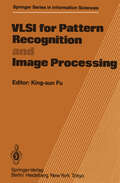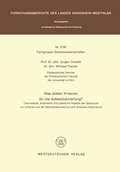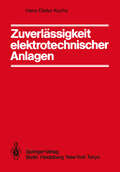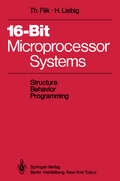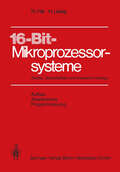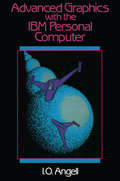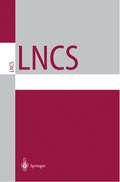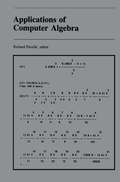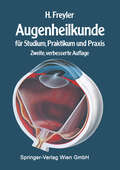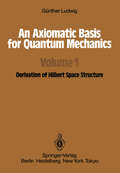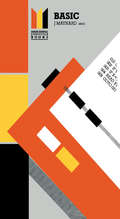- Table View
- List View
The Unix™ System Guidebook: An Introductory Guide for Serious Users (Springer Books on Professional Computing)
by P.P. SilvesterWell suited to medium-scale general purpose computing, the Unix time sharing operating system is deservedly popular with academic institutions, research laboratories, and commercial establishments alike. Its user com munity, which until recently was made up mostly of experienced computer professionals, is now attracting many people concerned with computer applications rather than systems. Such people are mainly interested in putting Unix software to work effectively, hence need a good knowledge of its external characteristics but not of its internal structure. The present book is intended for this new audience, people who have never encountered the Unix system before but who do have some acquaintance with computing. While helping the beginning user get started is a primary aim of this book, it is also intended to serve as a handy reference subsequently. However, it is not intended to replace the definitive Unix system documen tation. The Unix operating system as it now exists at most installations (popularly, though somewhat inaccurately, called Version 7 Unix) is sub stantially as described by the Seventh Edition of the system manuals. This book emphasizes Version 7 and systems closely related to it, but it does also describe some other facilities in wide use. Many people have been instrumental in shaping this book and the author wishes to express his gratitude to them all. Particular thanks are due to David Lowther, for our many helpful discussions; and to the many students whose suggestions enlivened the task.
Vectorization of Computer Programs with Applications to Computational Fluid Dynamics (Notes on Numerical Fluid Mechanics and Multidisciplinary Design #8)
by Wolfgang GentzschThe scope of the present book is to offer the most efficient tools for the vectorization of serial computer programs. Here, by vectorization we understand the adaptation of computer programs to the special architecture of modern available vector computers to exploit fully their potential, which will often result in remarkable performance improvements. The book is written primarily for users working in the various fields of computational physics, for scientists as well as for programmers running their jobs on a vector computer. The text may, however, also be of value to those who are interested in numerical algorithms. Although the examples discussed in chapter 9 have been taken from Computational Fluid Dynamics, the numerical methods are well-known, and are applied in many fields of Computational Physics. The book is divided into four parts. After a short introduction which outlines the limits of conventional serial computers in contrast to the possibilities offered by the new vector machines, the second part is addressed to the discussion of some main features of existing computer architectures. We restrict ourselves to the vector computers CRAY-1S and CDC-CYBER 205, although, in the meantime, many vector and parallel computers and array processors are available such as DENELCOR's Heterogeneous Element Processor (HEP), ICL's Distributed Array Processor (DAP), SPERRY UNIVAC's Array Processing System (APS), STAR TECHNOLOGIES ST-l00, FLOATING POINT SYSTEMS' Array Processor (FPS), FUJITSU's FACOM VP-l00 and VP-200, HITACHI's Integrated Array Processor (lAP), HITACHI's S 810/10 and S 810/20 and others.
VLSI for Pattern Recognition and Image Processing (Springer Series in Information Sciences #13)
by K. S. FuDuring the past two decades there has been a considerable growth in interest in problems of pattern recognition and image processing (PRIP). This inter est has created an increasing need for methods and techniques for the design of PRIP systems. PRIP involves analysis, classification and interpretation of data. Practical applications of PRIP include character recognition, re mote sensing, analysis of medical signals and images, fingerprint and face identification, target recognition and speech understanding. One difficulty in making PRIP systems practically feasible, and hence, more popularly used, is the requirement of computer time and storage. This situation is particularly serious when the patterns to be analyzed are quite complex. Thus it is of the utmost importance to investigate special comput er architectures and their implementations for PRIP. Since the advent of VLSI technology, it is possible to put thousands of components on one chip. This reduces the cost of processors and increases the processing speed. VLSI algorithms and their implementations have been recently developed for PRIP. This book is intended to document the recent major progress in VLSI system design for PRIP applications.
Was leisten Kriterien für die Aufsatzbeurteilung?: Theoretische, empirische und praktische Aspekte des Gebrauchs von Kriterien und der Mehrfachbeurteilung nach globalem Ersteindruck (Forschungsberichte des Landes Nordrhein-Westfalen #3192)
by Jürgen GrzesikZuverlässigkeit elektrotechnischer Anlagen: Einführung in die Methodik, die Verfahren und ihre Anwendung
by H.-D. Kochs16-Bit-Microprocessor Systems: Structure, Behavior, and Programming
by Thomas Flik Hans LiebigIn the last few years, a large number of books on microprocessors have appeared on the market. Most of them originated in the context of the 4-bit and the 8-bit microprocessors and their comparatively simple structure. However, the techno-logical development from 8-bit to 16-bit microprossors led to processor components with a substantially more complex structure and with an expanded functionality and also to an increase in the system architecture's complexity. This books takes this advancement into account. It examines 16-bit micro-processor systems and descrihes their structure, their behavior and their programming. The principles of computer or ganization are treated at the component level. This is done by means of a detailed examination of the characteristic functionali ty of microprocessors. Furthermore the interactions between hardware and software, that are typical of microprocessor technology, are introduced. Interfacing techniques are one of the focal points of these considerations. This puplication is organized as a textbook and is intended as a self-teaching course on 16-bit microprocessors for students of computer science and communications, design engineers and users in a wide variety of technical and scientific fields. Basic knowledge of boolean algebra is assumed. The choice of material is based on the 16-bit microprocessors that are currently available on the market; on the other hand, the presentation is not bound to anyone of these microprocessors.
Advances in Cryptology: Proceedings of CRYPTO '84 (Lecture Notes in Computer Science #196)
by G. R. Blakely D. ChaumRecently, there has been a lot of interest in provably "good" pseudo-random number generators [lo, 4, 14, 31. These cryptographically secure generators are "good" in the sense that they pass all probabilistic polynomial time statistical tests. However, despite these nice properties, the secure generators known so far suffer from the han- cap of being inefiicient; the most efiicient of these take n2 steps (one modular multip- cation, n being the length of the seed) to generate one bit. Pseudc-random number g- erators that are currently used in practice output n bits per multiplication (n2 steps). An important open problem was to output even two bits on each multiplication in a cryptographically secure way. This problem was stated by Blum, Blum & Shub [3] in the context of their z2 mod N generator. They further ask: how many bits can be o- put per multiplication, maintaining cryptographic security? In this paper we state a simple condition, the XOR-Condition and show that any generator satisfying this condition can output logn bits on each multiplication. We show that the XOR-Condition is satisfied by the lop least significant bits of the z2-mod N generator. The security of the z2 mod N generator was based on Quadratic Residu- ity [3]. This generator is an example of a Trapdoor Generator [13], and its trapdoor properties have been used in protocol design. We strengthen the security of this gene- tor by proving it as hard as factoring.
Advances in Cryptology: Proceedings of EUROCRYPT 84. A Workshop on the Theory and Application of Cryptographic Techniques - Paris, France, April 9-11, 1984 (Lecture Notes in Computer Science #209)
by Thomas Beth Norbert Cot Ingemar IngemarssonApple Macintosh Encyclopedia
by Gary PhillipsThe Apple Macintosh Encyclopedia provides easily accessible, brief and understandable information on the topics that you are most likely to have questions about. We have carefully digested the manuals, books, magazine articles, and other information sources for the Macintosh. These, combined with our own experience in using the Macintosh and other personal computers, have been integrated into an alphabetical sequence of short entries in the style of an encyclopedia. The goal is to provide concise, useful and easy-to-understand information on a particular topic that is quickly accessible when you need it. Much of the information in the entries is not contained in the manuals provided with the Macintosh and various software products. For example, notice the discussion, under WIDTH, of the "deferred" nature of this command when used with a device name, the discussion of the colon (:) in Multiplan for ranges, or Saving, Problems With. These topics are omitted or inadequately covered in the standard manuals. The Macintosh is the first truly visual computer. In keeping with the highly visual nature of using the Macintosh, we have provided over 100 illustrations. Each shows exactly what you will see on the screen when exploring topics discussed in the text. The Macintosh Encyclopedia opens with a visual guide to icons, and remains highly visual in orientation throughout the text.
Applications of Circularly Polarized Radiation Using Synchrotron and Ordinary Sources
by Fritz Allen Carlos Bustamanteviii The experimental research presented at the conference and reported here deals mainly with the visible wavelength region and slight extensions to either side (roughly from 150 nrn to 1000 nrn, 8. 3 eV to 1. 2 eV). A single exception was that dealing with a description of spin-resolved photoelectron spectroscopy at energies up to 40 eV (31 nm). This work was done using circularly polarized radiation emitted above and below the plane of the circulating electrons in a synchrotron ring. The device at BESSY (West Germany) in which the experiments were carried out seems to be the only one presently capable of providing circularly polarized radiation in the X--ray through vacuum ultraviolet energy range. A much more intense source is needed in this range. A possible solution was proposed which could provide not only circularly polarized photons over a wide energy range, but could in principle modulate the polarization of the beam between two orthogonal polarization states. Realization of this device, or an equivalent one, would be a vital step towards the goal of determining all components of the Mueller matrix for each spectroscopic experiment. A variety of theoretical treatments are presented describing the different phenomena emerging from the interaction of matter and polarized radiation in a wide range of energies. From this work we expect to learn what are the most useful wavelength regions and what types of samples are the most suitable for study.
Applications of Computer Algebra
by Richard PavelleToday, certain computer software systems exist which surpass the computational ability of researchers when their mathematical techniques are applied to many areas of science and engineering. These computer systems can perform a large portion of the calculations seen in mathematical analysis. Despite this massive power, thousands of people use these systems as a routine resource for everyday calculations. These software programs are commonly called "Computer Algebra" systems. They have names such as MACSYMA, MAPLE, muMATH, REDUCE and SMP. They are receiving credit as a computational aid with in creasing regularity in articles in the scientific and engineering literature. When most people think about computers and scientific research these days, they imagine a machine grinding away, processing numbers arithmetically. It is not generally realized that, for a number of years, computers have been performing non-numeric computations. This means, for example, that one inputs an equa tion and obtains a closed form analytic answer. It is these Computer Algebra systems, their capabilities, and applications which are the subject of the papers in this volume.
Applied Dynamics and CAD of Manipulation Robots (Communications and Control Engineering #6)
by M. Vukobratovic V. PotkonjakThis book is a logical continuation of Volume 1 of the series entitled "Scientific Fundamentals of Robotics" which presents all of the basic methods for computerized construction of dynamics of manipulation ro bots as well as the essential concepts of computer-aided design of their mechanics. Vol. 1 of the Series also contains the main practical re sults from the elastodynamics of manipulation robots, having in mind a need for forming a computer procedure which allows efficient checks of elastic deformations of a manipulator tip or some other of its charac teristic points. Wishing to add a highly applications-oriented dimension to the dynamic aspect of studies of manipulation robots, the authors have made a kind of a topic-based selection by leaving unconsidered some aspects of studies of robots, such as elasticity, and discussing others, more im portant in their opinion, to such an extent as suffices to make them practically applicable. The authors have decided not to treat in detail the problem of flexible manipulation robots for two reasons. The first results from the atti tude that the permissible (desired) robot elasticity may, satisfacto rily well, be tested using the method described in Vol. 1 of the Series.
Architecture of Systems Problem Solving
by George J. KlirOne criterion for classifying books is whether they are written for a single purpose or for multiple purposes. This book belongs to the category of multipurpose books, but one of its roles is predominant-it is primarily a textbook. As such, it can be used for a variety of courses at the first-year graduate or upper-division undergraduate level. A common characteristic of these courses is that they cover fundamental systems concepts, major categories of systems problems, and some selected methods for dealing with these problems at a rather general level. A unique feature of the book is that the concepts, problems, and methods are introduced in the context of an architectural formulation of an expert system referred to as the general systems problem solver or GSPS-whose aim is to provide users of all kinds with computer-based systems knowledge and methodology. The GSPS architecture, which is developed throughout the book, facilitates a framework that is conducive to a coherent, comprehensive, and pragmatic coverage of systems fundamentals--concepts, problems, and methods. A course that covers systems fundamentals is now offered not only in systems ~cience, information science, or systems engineering programs, but in many programs in other disciplines as well. Although the level of coverage for systems science or engineering students is surely different from that used for students in other disciplines, this book is designed to serve both of these needs.
Aspekte der Informationsverarbeitung: Funktion des Sehsystems und technische Bilddarbietung (Fachberichte Messen - Steuern - Regeln #13)
by Hans-Walter BodmannAn Axiomatic Basis for Quantum Mechanics: Volume 1 Derivation of Hilbert Space Structure
by G. LudwigThis book is the first volume of a two-volume work, which is an improved version of a preprint [47] published in German. We seek to deduce the funda mental concepts of quantum mechanics solely from a description of macroscopic devices. The microscopic systems such as electrons, atoms, etc. must be detected on the basis of the macroscopic behavior of the devices. This detection resembles the detection of the dinosaurs on the basis offossils. In this first volume we develop a general description of macroscopic systems by trajectories in state spaces. This general description is a basis for the special de scription of devices consisting of two parts, where the first part is acting on the second. The microsystems are discovered as systems transmitting the action. Axioms which describe general empirical structures of the interactions between the two parts of each device, give rise to a derivation of the Hilbert space structure of quantum mechanics. Possibly, these axioms (and consequently the Hilbert space structure) may fail to describe other realms than the structure of atoms and mole cules, for instance the "elementary particles". This book supplements ref. [2]. Both together not only give an extensive foundation of quantum mechanics but also a solution in principle of the measuring problem.
BASIC-Programme zur Regelungstechnik: Stabilitätsuntersuchung von Regelkreisen und Fahrkurvensimulation mit dem Sirius (Vieweg Programmbibliothek Mikrocomputer #29)
by Peter F. Orlowski Rudolf DiehlIm schulischen Bereich und in der Projektierung von Industrie anlagen werden in zunehmendem Maße Personal-Computer (PCs) zur Lösung von Aufgaben der Regeltechnik eingesetzt. In diesem Beitrag werden zwei BASIC-Programme (MS-BASIC) vorge stellt, die sich besonders zur Optimierung linearer, einschlei figer Regelkreise eignen, bei denen die Parameter der Regel strecke bekannt sind. Die Programme sind für den Sirius-Rechner geschrieben, da er mit 400 x 800 Bildpunkten eine sehr gute Auflösung bietet. De finiert man die zu Anfang der Programme aufgeführten Graphik Befehle auf einen anderen Rechner bezogen, so sind sie dort auch lauffähig. Vergleichbare Veröffentlichungen sind von /1/, /2/ und /3/ erschienen. Vorteil des PC-Einsatzes ist die anschauliche Darstellung von Parameter-Einflüssen auf die Regelung mit Hilfe der Bildschirm Graphik. So wird eine optimale Einstellung des Reglers auf die Regelstrecke möglich. Die hier zugrunde liegende Stabilitätsbetrachtung geht von dem vereinfachten Stabilitäts-Kriterium nach Nyquist /4/ aus. Es kann vom Anwender als Nyquist- oder Bode-Diagramm in hochauf lösender Graphik ausgewertet werden. Die Anwendung der Programme als komplette Diskette /5/ erfordert keine besonderen Programmier-Kenntnisse, da der Systemstart und das Laden aller Routinen (GRAFIX; MS-BASIC ..• ) automatisch er folgt. Alle Ergebnisse lassen sich auf den üblichen Speichermedien ab legen bzw. plotten oder ausdrucken. 2 Stabilitätsuntersuchung 2 Stabilität nach Nyquist Ein einschleifiger Regelkreis stellt eine Wirkungskette von Regler und Regelstrecke mit Rückkopplung dar. Er ist folglich auf Stabilität zu untersuchen. Das allgemein bekannte vereinfachte Stabilitäts-Kriterium nach NYQuist liefert für die meisten technisch realisierbaren linea ren Regelungen eine hinreichende Stabilitäts-Bedingung.
BASIC-Wegweiser für den Commodore 116, Commodore 16 und Commodore plus/4
by Ekkehard KaierDas vorliegende Wegweiser-Buch weist Wege zum erfolgreichen Einsatz des Commodore 116, Commodore 16 und Commodore plus/4. Das Wegweiser-Buch vermittelt aktuelles Grundlagenwissen zur Datenver arbeitung bzw. Informatik: -Was ist Hardware, Software und Firmware? - Was sind Großcomputer und Mikrocomputer? - Was sind Datenstrukturen und Programmstrukturen? -Was sind Betriebssysteme und Anwenderprogramme? -Was heißt ,fertige Programm-Pakete einsetzen'? - Was beinhaltet das eigene Programmieren? Nach der Lektüre dieses Abschnitts sind Sie in der Lage, die Commodore Computer in den Gesamtrahmen der "Datenverarbeitung/Informatik" ein zuordnen. Das Wegweiser-Buch gibt eine erste Bedienungsanleitung: -Wie bediene ich Tastatur, Bildschirm, Floppy bzw. Disketteneinheit und Drucker des C-116, C-16 und plus/4. - Wie erstelle ich mein erstes Programm in der Programmiersprache BASIC 3.5? -Welche Befehle umfaßt BASIC 3.5 (zu jedem Befehl wird ein Beispiel angegeben)? - Worin unterscheiden sich BASIC 3.5 von den anderen Sprachversionen BASIC 2.0 und BASIC 4.0? - Laufen Programme des C-116, C-16 und plus/4 auch auf anderen Mik- computern von Commodore? Nach der Lektüre dieses Abschnitts können Sie ihren C-116, C-16 und plus/4 bedienen, Programme laufen lassen und einfache BASIC-Programme selbst erstellen und speichern. Das Wegweiser-Buch enthält einen kompletten Programmierkurs mit folgen den grundlegenden BASIC-Anwendungen: - Programme mit den wichtigen Ablaufstrukturen (Folge-, Auswahl-, Wiederholungs-und Unterprogrammstrukturen). - Verarbeitung von Text, Ein-/Ausgabe und Tabellen. - Maschinennahe Programmierung ( ... Bit für Bit). -Suchen, Sortieren, Mischen und Gruppieren von Daten.




